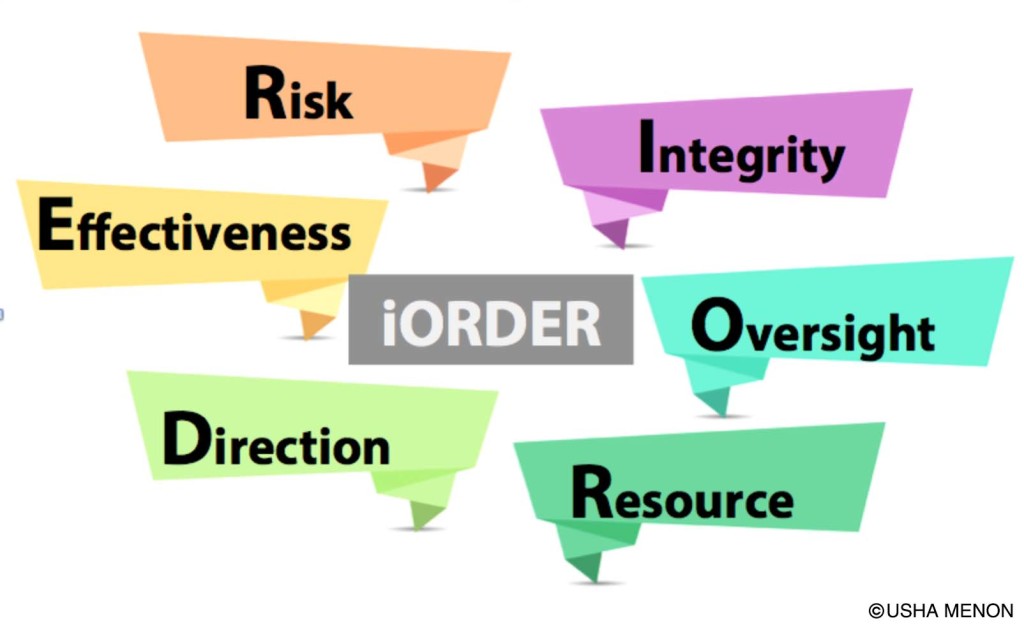
iORDER – Duty of Care and Prudence
Nonprofit boards have a duty of care and prudence in performing its role. This fact is well known and accepted. However, as stewards of nonprofit organizations, knowing what these duties entail and how to operationalize their responsibilities are issues faced by the board members.
Here is a mnemonic that I have devised to help us recognize and remember the key duties related responsibilities and practices of nonprofit boards:
Integrity
Maintaining integrity and hence the public trust in the organization is a paramount duty of the nonprofit board. The 2016 Edelman Trust Barometer results drive home the importance of this duty. Compared with institutions of business, media and government the trust placed by informed public and the general population is highest in the nonprofit/ NGO sector. Over the years, nonprofits have maintained this position at the top globally and in Singapore. Upholding integrity involves the board reviewing and updating the nonprofit bylaws, policies, procedures, strengthening accountability and board performance. Hence the responsibilities range from applying effective board meeting practices to technical knowledge needed for carrying out legal duties.
Oversight
Providing program, financial and management oversight requires that the board determines monitors and shapes the services delivered by the nonprofit. It is also responsible for the optimization of resources, both financial and human, by reviewing the alignment of organizational priorities with the annual budgets as well as staff and board structures needed to implement these priorities.
Appropriate oversight is only possible if the board sets clear guidelines on the type and frequency of information that it needs and the criteria it will apply to evaluate program, financial and management performance.
Resources
Ensuring resources in the form of funds, partnerships, collaborations and networks is an important duty. The board should be able to analyse resource requirements, approve fundraising and revenue generation strategies and evaluate fundraising performance. The board’s ability to identify lead indicators for decision making and using appropriate evaluation tool to assess the effectiveness of fundraising methodologies makes for a strong resource mobilization board. The Charity Transparency Scorecard developed by the Charity Council in Singapore provides a useful tool for charities and the public to understand the level of governance practices and key areas of disclosure that will aid in informed giving.
Direction
Setting directions aligned with the vision and mission of the nonprofit and guiding the organizational strategy that fulfills the mission is a core responsibility of the nonprofit board. This requires the ability to assess the changes in the organization and the community environment, so that the strategic direction and policy decisions are relevant to the nonprofit’s stakeholders, its clients and the community. Periodic reviews of the mission vision and values by the board helps the nonprofit stay relevant and appropriate in the fast changing social environment. The board also has a duty to guide the design and development of an eco-system for innovation to achieve the nonprofit mission.
Effectiveness
An effective board is essential to the nonprofit’s ability to achieve impact. This requires that the board evaluate its own performance and plan for development, diversity and succession. This is achieved by establishing and enforcing policies related to board terms, skills composition and identifying areas for governance improvement. Creating an environment of trust and common vision within the board as well as recognise the distinct roles played by the board, its committees and management staff are important features of an effective board. Formally evaluating the chief executive officer and approving appropriate compensation for the key staff appointments are part of the board duties along with giving the management enough authority to lead the staff and manage the operations of the nonprofit.
Risk
Managing risk is an important component of governance and the board is responsible for developing related policies and guiding the risk management process. This involves understanding risk categories eg: social objectives, program effectives, fundraising and handling of donations amongst others and identifying the risks within these categories. Internal controls help to manage risks. Implementation of internal controls is the role of management, however the board through its various committees eg: nomination, audit, program, fundraising, is responsible for evaluating risks, approving strategies for mitigating risks and monitoring the implementation of the risk management process.
The iORDER model described above provides an overview of the key duties, responsibilities and practices of the nonprofit board. Each of these areas requires skill sets and relevant experience on the board to successfully govern the nonprofit.
Good governance is an opportunity to show all stakeholders the accountability, trustworthiness and effective performance of the nonprofit. The responsibility of making the best of this opportunity lies squarely on the shoulders of the nonprofit board.
ที่มา http://www.resource-alliance.org/iorder-duty-of-care-and-prudence/


